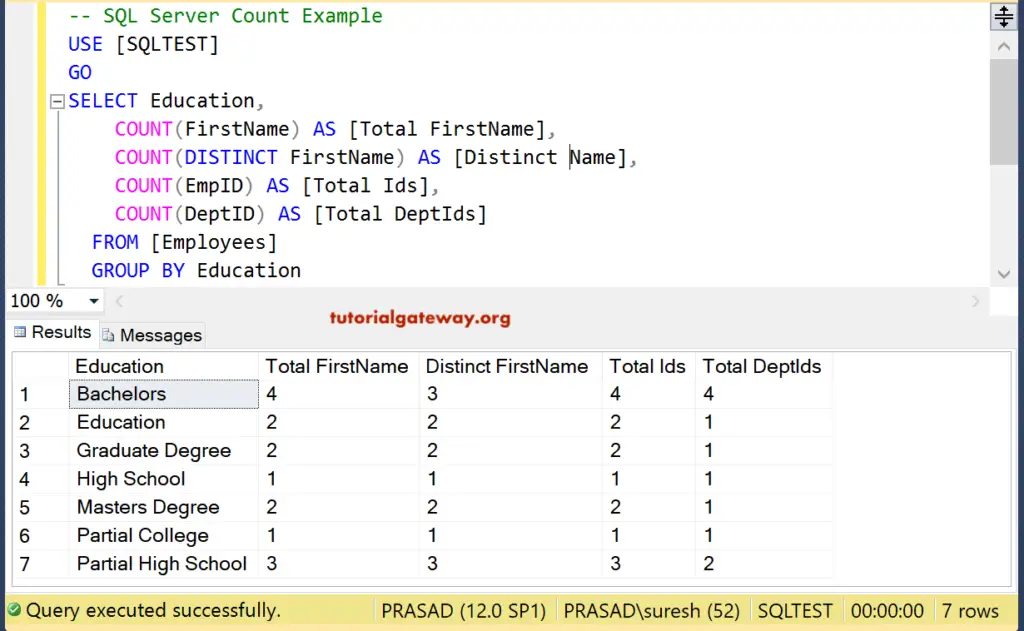
SQL HOME SQL Intro SQL Syntax SQL Select SQL Select Distinct SQL Where SQL An Or, Not SQL Order By SQL Insert Into SQL Null Values SQL Update SQL Delete SQL Select Top SQL Min and Max SQL Count , Avg, Sum SQL Like SQL Wildcards SQL In SQL Between SQL Aliases SQL Joins SQL Inner Join SQL Left Join SQL Right Join SQL Full Join SQL Self Join SQL. The HAVING clause with SQL COUNT() function can be used to set a condition with the select statement. The GROUP BY with HAVING clause retrieves the result for a specific group of a column, which matches the condition specified in the HAVING clause. Der SQL Befehl HAVING kann man als WHERE des GROUP BY bezeichnen.
HAVING folgt immer dem GROUP BY, kann also nicht davor stehen. Mit HAVING kann man die Ausgabe auf. Mit WHERE kann man nur einen bestimmten Bereich einschränken, sobald man Werte gruppiert und Einschränkungen anhand der Gruppierung machen möchte, benötigt man HAVING.
Gerade für die weiteren SQL Funktionen, auf die wir im nächsten Teil eingehen werden, wird HAVING häufig benötigt. Only include countries with more than customers. HAVING wird in der Regel mit einer GROUP BY-Klausel verwendet. HAVING is typically used with a GROUP BY clause.
Wenn GROUP BY nicht verwendet wir gibt es eine implizite einzelne, aggregierte Gruppe. When GROUP BY is not use there is an implicit single, aggregated group. Transact- SQL -Syntaxkonventionen Transact- SQL Syntax Conventions.
If the HAVING clause contains a subquery, the subquery can refer to the outer query block if and only if it refers to a grouping column. Ask Question Asked years, months ago. Active years, months ago. Viewed 559k times 161.
I have a table named PAYMENT. The text, image, and ntext data types cannot be used in a HAVING clause. So könnten wir zum Beispiel nur diejenigen Warenhäuser anzeigen lassen, die einen Umsatz von mehr als 1. The Oracle HAVING clause will filter the so that only departments with. The following statement returns the brand and the number of products for each.
In addition, it returns only the brands that have the number of. You could also use the SQL SUM function to return the name of the department and the total sales (in the associated department). Secon the HAVING clause filtered out all the customers whose number of orders is less than two.
I am fairly new to SQL. Die SQL -Abfrage ist dieselbe wie unter Beispiel es wurde nur die HAVING -Klausel hinzugefügt. Artikel wird ausgegeben. The sql having also be used with sql max function.
COUNT : Ermittlung der Zeilen bzw. For example, you can use the HAVING clause to answer questions like finding the number orders this month, this quarter, or this year that have total sales greater than 10K. Das SQL HAVING –Statement ist das SQL WHERE in einem SQL GROUP BY-Statement.
In this tutorial, you will learn how to use the PostgreSQL HAVING clause to eliminate groups of rows that do not satisfy a specified condition. Es ermöglicht eine gruppierte Ergebnismenge einzuschränken. A HAVING clause in SQL specifies that an SQL SELECT statement should only return rows where aggregate values meet the specified conditions.
It was added to the SQL language because the WHERE keyword could not be used with aggregate functions. GROUP BY 和 HAVING 的使用 count ()在介绍GROUP BY 和 HAVING 子句前,我们必需先讲讲 sql 语言中一种特殊的函数:聚合函数,例如SUM, COUNT. The SQL HAVING clause will then filter the so that only. The RID built-in function and the ROW CHANGE expression cannot be specified in a HAVING clause unless they are within an aggregate function.
Row access controls do not affect the operation of the HAVING clause. Oracle GROUP BY HAVING will group values that have a particular value.
Keine Kommentare:
Kommentar veröffentlichen
Hinweis: Nur ein Mitglied dieses Blogs kann Kommentare posten.